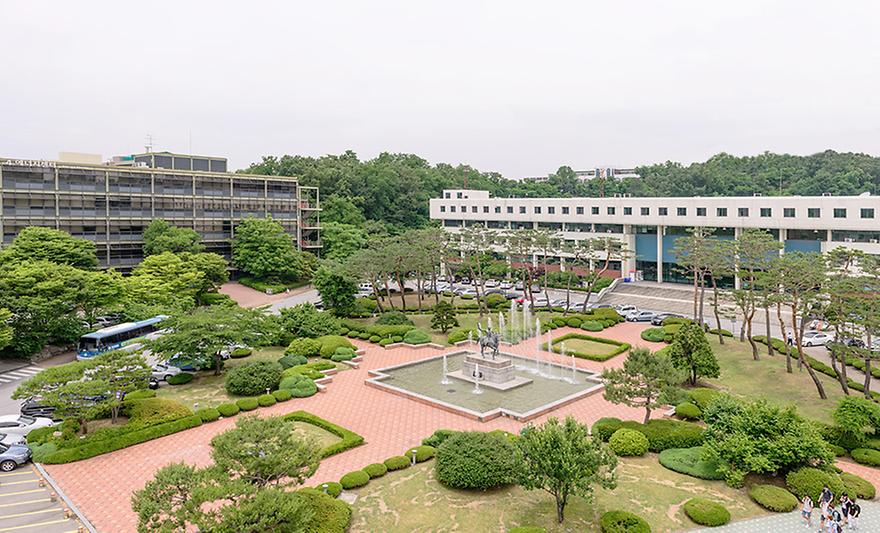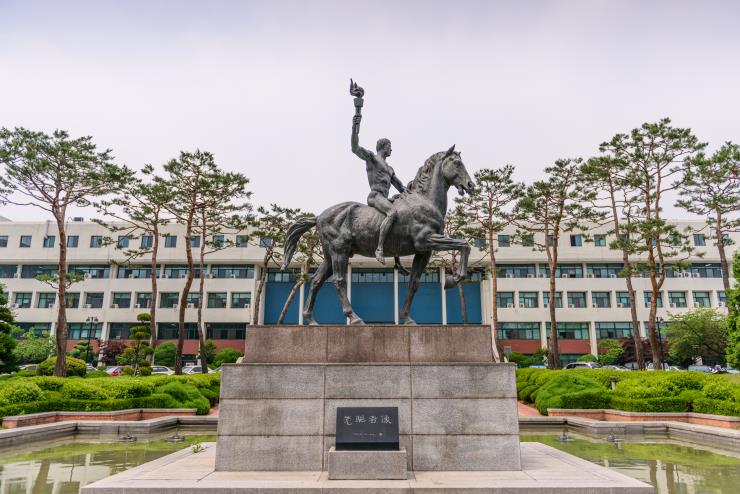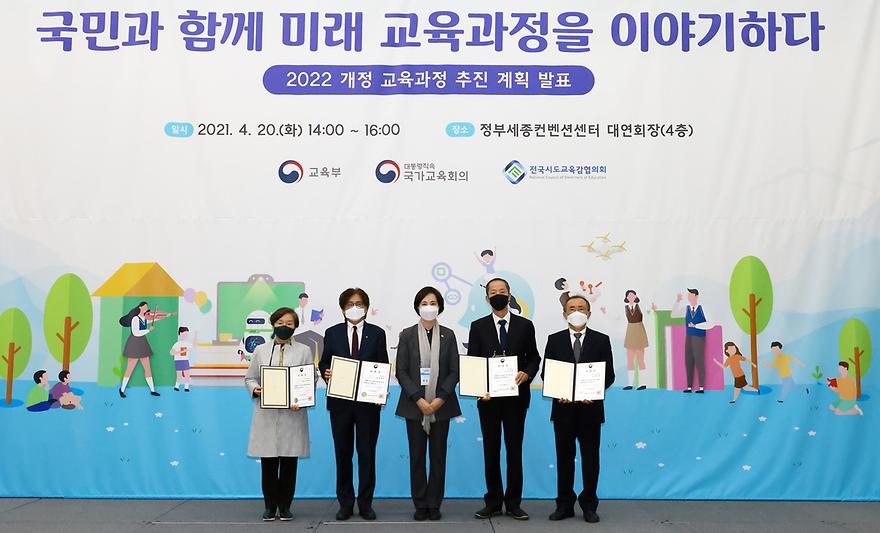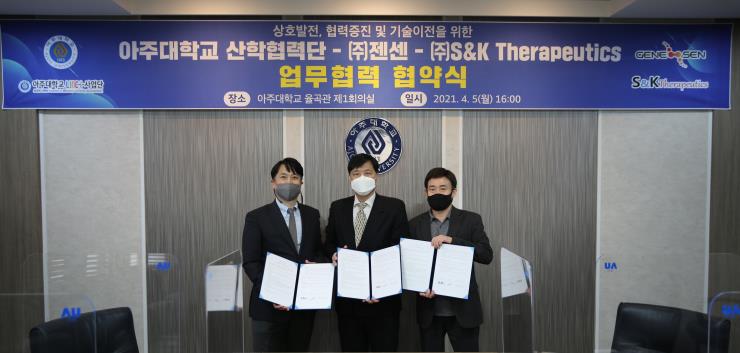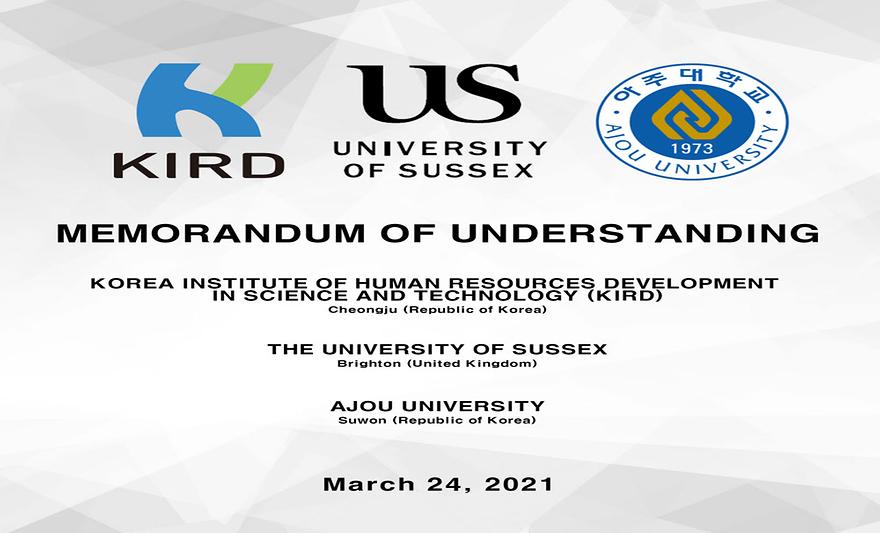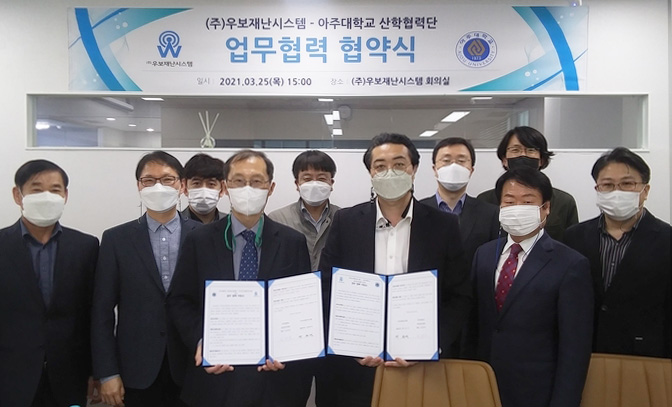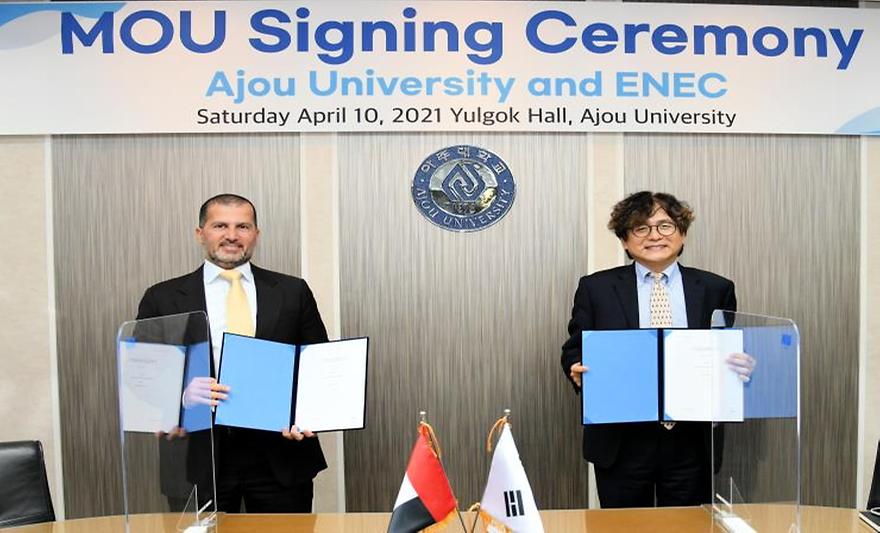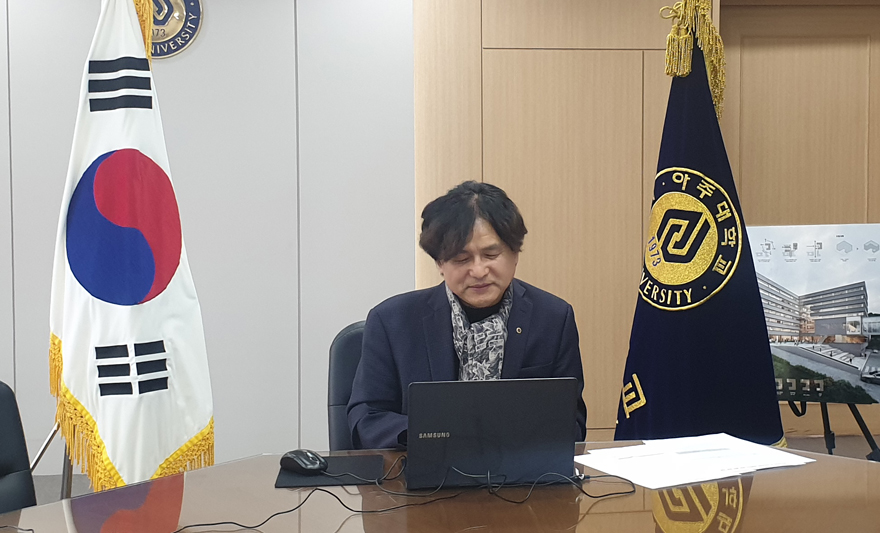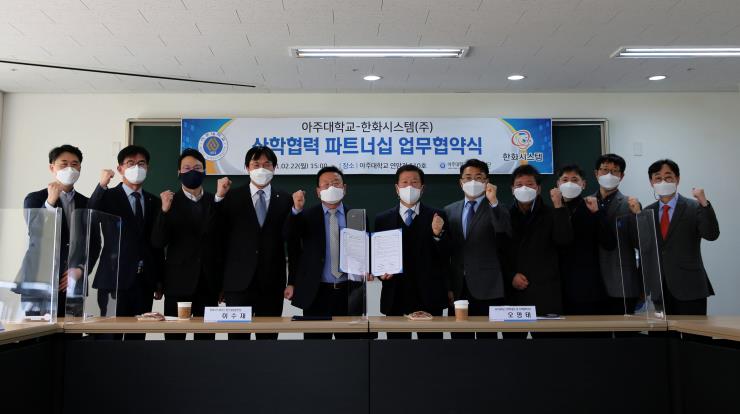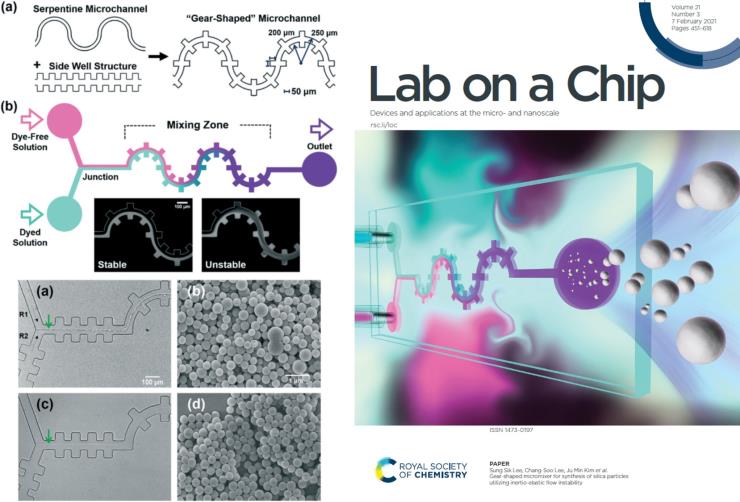-
Ajou University was designated for participation in the Ministry of Science and ICT’s Korea Initiative for Fostering University of Research & Innovation (KIURI) Project.The KIURI Project was initiated in 2020 to make researchers with PhDs in science and engineering independent and promote their entry into industry.The three-year project will run from May 2021 to October 2024 with a grant of KRW 1.5 billion per year. Post-doc researchers taking part in the project will receive research grants of around KRW 100 million per year, including labor costs, for up to three years.Accordingly, the school established the AI-Super Convergence KIURI Translational Research Group to Combat Disease (led by Kim Byung-gon, Professor of Brain Science and Neurology) to produce the human resources needed in basic biomedical science, translational research between clinical medicine fields, development of AI-based new drugs, and new bio materials to manage bodily functions.It will also build a cooperative network with 21 bio firms located in Southern Gyeonggi Province, including Huons, OliPass, Plarit, and Frombio, to develop technology needed by corporations and provide advice and dispatch researchers to offer practical support to companies seeking to increase their development capacities.The school will recruit 12 post-doc researchers in different majors from colleges of medicine, engineering, pharmacy, and natural sciences by the end of August 2021. It will develop programs for the newly recruited researchers and match them with faculty mentors and participating businesses in related fields to engage in industry-academia convergence research.Four university research groups have been assigned to the KIURI Project, including Seoul National University (bio-health), Sungkyunkwan University (energy and environment), Yonsei University (future car materials and parts), and Pohang University of Science and Technology (diagnostics and therapeutics), and 68 post-doc researchers have been carrying out research since 2020. This year, Ajou University and Inha University were designated, with each adding 12 new researchers. A total of 92 post-doc researchers will develop into leading personnel in industrial innovation.Ajou UniversityResearch group focused on new post-doc research personnelPartners:Middle market businesses/SMEs and bio ventures located in southern Gyeonggi ProvinceRegulations on support system and promotions:Guarantees stable position for new researchersAI-super convergence KIURI Translational Research Group to Combat DiseaseCreate startup ecosystemBuild industry-academia cooperation platform: Ajou Translational Research Center (ATRC)School of Medicine Address lack of human resourcesSupport strengthening of independent research capacity: Support capacity for industrial innovation in creative cutting-edge researchCollege of PharmacyDevelop competitiveness in bio technologyBuild infrastructure to enhance academic excellence: Support information and technology for academic research and educationCollege of Engineering, College of Natural SciencesAcquire competitiveness in Industry 4.0Artificial Intelligence (AI)Bio- and Pharma-hubs in southern Gyeonggi Province
-
502
- 작성자OIA
- 작성일2021-05-24
- 5474
- 동영상동영상
-
Ajou University was chosen to participate in the R&D Project to Nurture Human Resources in Regulatory Science, sponsored by the Ministry of Food and Drug Safety (MFDS), and will receive a subsidy of KRW 2.5 billion in total over the next five years.Regulatory science involves the development of new tools, criteria, and approaches to evaluate safety, validity, quality, and performance, among others, of food, drugs, medical devices and other regulated products. Recent growth in the bio-health industry has triggered a notable increase in demand for human resources in this field.The R&D Project to Nurture Human Resources in Regulatory Science is a new government-funded initiative in 2021 by the MFDS and aims at developing researchers and field experts to lead new industries in regulatory science through trilateral cooperation among industry, academia, and research institutes.The selection of universities to carry out the project occurred through a contest in which the MFDS designated projects in the three fields of pharmaceuticals, medical devices, and food. Ajou University was chosen for ‘Evaluation of Pharmaceutical Product Safety’ (managed by the College of Pharmacy; Chief of Research Lee Suk-hyang, Dean of the College of Pharmacy). As a result, the College of Pharmacy will begin a graduate program in Bio-health and Regulatory Science and invite 20 new students beginning the second semester of the 2021 academic year.The curriculum for Bio-health and Regulatory Science majors will focus on on-site, practical education, which will include Advanced Theory on Regulatory Science, International Council for Harmonization of Technical Requirements for Pharmaceuticals for Human Use (ICH) Guidelines, Clinical Pharmacology, Evidence-based Regulatory Decision-making, Big Data (RWD/RWE) Analysis and internships at bio-pharma companies.Graduates will be able to move on to numerous entities, including pharmaceutical research institutes and bio-health safety evaluation companies, or work as regulatory science legal experts in relation to certification of contract research organizations (CROs) or healthcare data analysts.Throughout this project, Ajou University plans to cultivate more than 120 core persons to lead the global regulatory science industry. To achieve this goal, the major will begin in the second semester this year and the Department of Bio-health Regulatory Science in 2022.
-
500
- 작성자OIA
- 작성일2021-05-24
- 4931
- 동영상동영상
-
President of Ajou University Park Hyung-ju has been appointed chair of the Ministry of Education’s National Curriculum Reform Research Committee. An appointment ceremony was held at the Government Complex Sejong Convention Center in Sejong City on April 20, 2021 and a letter of appointment presented by Deputy Prime Minister and Minister of Education Yoo Eun-hae to President Park and other commissioners.The National Curriculum Reform Research Committee was set up to revise the curriculum for elementary, middle and high schools to respond to a changing education environment, including rapid social changes from acceleration of AI and Industry 4.0 and a decline in the number of students, and prepare for a transition to education more geared towards the future.The Committee is comprised of experts from different fields, including teachers and members of academia and related institutions, and representatives of civil society and will engage in research and development of curricula, discuss issues and operational matters regarding the curricula, and devise a revised curriculum.The Committee will gather opinions from forums, online discussions, hearings, and deliberative meetings as it builds the revised curricula, and acquiring social consent on the revisions, making a public announcement during the fall of 2022.
-
498
- 작성자OIA
- 작성일2021-05-24
- 4875
- 동영상동영상
-
Ajou University Industry-Academic Cooperation Foundation signed a memorandum of understanding (MOU) with new drug development ventures Genesen and S&K Therapeutics. The three institutions will be working closely together to commercialize treatment for autoimmune and inflammatory diseases.A signing ceremony was held at Yulgok Hall on April 5, 2021 and attended by Industry-Academic Cooperation Foundation Director and Head of LINC+ Project Group Professor Kwon Yong-jin, Genesen CEO Lee Sung-ho, and S&K Therapeutics CEO Choi Sang-dun, who is also a professor in the Departments of Biological Sciences and Molecular Science and Technology at Ajou University. Genesen is a venture developing new peptide drugs using molecular modeling. In 2018, it signed a technology transfer agreement, worth KRW 4 billion, for peptide-based autoimmune disease treatment candidate material developed by the research team led by Professor Choi.This latest agreement will enable Genesen to receive the technology of a follow-up peptide candidate material developed by the Ajou University research team and expand R&D pipelines. The follow-up technology transfer is valued at around KRW 1 billion.S&K Therapeutics, founded in 2020 by Professor Choi, who led the R&D on this technology, was also party to the agreement. It specializes in the development of small molecule therapies for inflammatory diseases.With the agreement, Ajou University Industry-Academic Cooperation Foundation will support the commercialization of peptide drugs for autoimmune disease with Genesen and engage in strategic cooperation with S&K Therapeutics for commercialization of chemical compound therapy for inflammatory diseases. The two companies agreed to cooperate towards mutual development going forward.
-
496
- 작성자OIA
- 작성일2021-05-24
- 5644
- 동영상동영상
-
Ajou University’s New Industry Convergence Technology R&D Center signed a trilateral agreement with the Korea Institute of Human Resources Development in Science and Technology (KIRD) and the University of Sussex Science Policy Research Unit (SPRU).The signing ceremony was conducted in a contactless environment. The agreement will enable the three institutions to work together in many fields of research and education, including construction of a science and technology policy network, development of human resources in science and technology in Korea, and sharing of Europe’s policy model in developing talent in science and technology.To this end, the three parties will conduct joint research on science and technology policy, jointly plan and operate education programs, cooperate in exchange student and training programs, exchange personnel in science and technology policy and arrange visits, and share information on education and research in science and technology policy.Founded in 2015, the New Industry Convergence Technology R&D Center works with businesses and the government in carrying out joint industry-academia research projects and cultivation of future human resources for the promotion of research in new industry convergence technology, such as smart grids, smart factories, and smart fintech.Center Director Lee Joo-yeon stated, “We hope the global cooperation in education and research on science and technology policy will cultivate world-leading professionals in this field and promote practical research.”
-
494
- 작성자OIA
- 작성일2021-05-24
- 3298
- 동영상동영상
-
Ajou University’s MR-IoT Convergence Disaster Response AI Research Center (hereafter, “MR-IoT Research Center”) signed a memorandum of understanding (MOU) with Woobo Systems to conduct research in disaster response AI.The signing ceremony was held at Woobo Systems on April 25, 2021 and attended by MR-IoT Research Center Director Roh Byeong-hee (Professor of Software at Ajou University) and Woobo Systems CEO Chang Hee-seok, along with staff from both institutions.The agreement enables the parties to build a cooperative system in research for the development of mixed reality (MR) and Internet-of-Things (IoT) convergence technology, develop public research projects, such as in the field of disaster response, utilizing Industry 4.0 technologies (AR, VR, IoT, and AI, etc.), and to cooperate in other matters of common interest.Woobo Systems specializes in the development and manufacture of integrated disaster prevention systems against natural and social disasters—climate equipment and systems for observation, disaster forecasting, and warning.“MR-IoT convergence AI technology supports decision-making and is considered one of the most important fields in future industries,” says Director Roh. “We will devote our efforts to leading AI technology and cultivating experts in this field.”CEO Chang commented, “We have constantly been working on the application of IoT and AI technologies by taking part in disaster safety projects with the central and local governments and developing disaster prevention systems. […] With this opportunity to work together with academia, we will engage in technology R&D that will involve converging MR technology with disaster response.”Ajou University was appointed to take part in the “University ICT Research Center Project” sponsored by the Ministry of Science and ICT in 2018 and established the MR-IoT Convergence Disaster Response AI Research Center. The Center shares technology and information on disasters and safety with various institutions in Korea and abroad through cooperation and MOUs and develops and researches MR and IoT convergence equipment.
-
492
- 작성자OIA
- 작성일2021-05-24
- 3386
- 동영상동영상
-
Abu Dhabi, United Arab Emirates, 10 April 2021: The Emirates Nuclear Energy Corporation (ENEC) has signed a Memorandum of Understanding (MoU) with Ajou University, a leading research institution based in Gyeonggi-do, South Korea. The MoU will provide a framework for collaboration for research & development (R&D) and innovation in the energy fields. The MoU was signed by His Excellency Mohamed Ibrahim AL Hammadi the Chief Executive Officer of ENEC and Dr. Hyungju Park President of Ajou University.The MOU reinforces the continuous collaboration between the UAE & the Republic of Korea in the R&D fields, building on the strong relationship between the two nations and opening the door for new opportunities across various sectors in the energy industry for both countries.With signing the memorandum of understanding, Ajou University and the Emirates Nuclear Power Corporation(ENEC) will collaborate to develop research in the energy industry, including nuclear power, and also to cultivate human resources.They also agreed to expand cooperation fields by starting joint research in industrial mathematics. ENEC is responsible for developing the UAE Peaceful Nuclear Energy Program and its flagship Barakah Nuclear Energy Plant, one of the largest nuclear plants globally. Established in 2009, ENEC is delivering safe, clean, efficient and reliable electricity through nuclear energy to support the UAE’s sustainable social and economic growth.ENEC recently celebrated its most historic milestone to date with the start of commercial operations of Unit 1 of the Barakah Nuclear Energy Plant. The Unit produces 1,400 MW of emissions-free electricity 24/7 to power homes and business across the UAE, driving the largest decarbonization effort in the country and helping to tackle climate change.
-
490
- 작성자OIA
- 작성일2021-04-19
- 4946
- 동영상동영상
-
Ajou University signed a memorandum of understanding (MOU) with the city of Suwon to cooperate over fostering the local new and renewable energy industry. The MOU signing ceremony took place online on February 5, attended by University President Park Hyung-ju and Suwon’s Mayor Yeom Tae-young. The memorandum led both parties to affirm their commitment to close cooperation on fostering new and renewable energy businesses and a culture of energy diversification.Under the new agreement, the two parties intend to co-organize programs towards developing the new and renewable energy industry and facilitating energy transition, and also to work together on running a regional energy center. The two parties also discussed possible cooperation over the joint research and development of new energy technologies.Specifically, the two parties agreed to assemble a board of advisors on new and renewable energy (especially hydrogen), connect Suwon’s regional energy center with Ajou’s, increase support for use of new and renewable energy by local government agencies, businesses, and research institutes, launch campaigns to usher in a shift in energy paradigm, and support Ajou’s BK21 projects.Ajou, for its part, will prioritize providing energy-related education and advice and accelerating academic, research, and technical activities.Since identifying the core areas of industry-university cooperation it is particularly suited to specialize in, Ajou University has opened industrial cooperation centers (ICCs) to develop local businesses in these areas. There are currently four ICCs, dedicated to smart mobility, biotechnology and healthcare, new and renewable energy, and AI and big data.
-
488
- 작성자OIA
- 작성일2021-03-19
- 7635
- 동영상동영상
-
-
486
- 작성자OIA
- 작성일2021-03-19
- 7647
- 동영상동영상
-
Ajou University has signed a memorandum of understanding (MOU) with Hanhwa Systems, agreeing to organize and strengthen research collaboration over self-driving mobility. A ceremony was held on February 22 at Yeonam Hall on campus to mark the signing of the memorandum. Executive Vice President for University-Industry Cooperation Oh Yeong-tae and Hanhwa Systems’ R&D Director Lee Su-jae [KHTC1]signed and exchanged two copies of the memorandum. The ceremony was also attended by Hanhwa Systems researchers and Ajou faculty members affiliated with the ACES Mobility Industrial Cooperation Center[KHTC2], including Prof. Song Bong-seob (Department of Mechanical Engineering) who chairs the center. This MOU paves the way for increased collaboration between Ajou and Hanhwa specifically over research and development of night vision technology, the use of available research equipment and infrastructure, organization of a committee and exchange of technical advice, and development of related education and training programs. Car-mounted thermal-imaging night vision cameras are essential to nighttime safety with self-driving cars. Designed to provide cars with vision during both the day and night and particularly in visibility-compromised conditions, night vision technology is emerging as a key to the success of autonomic mobility. Ajou and Hanhwa Systems will work together closely toward developing an intelligent, AI-controlled thermal imaging engine module to be mounted on existing models of thermal imaging cameras. Ajou University’s LINC+ Project Group runs a number of industrial cooperation centers (ICCs) to strengthen the University’s research specialties through collaboration with local businesses and industries. There are currently four ICCs dedicated to smart mobility, biotechnology and healthcare, new and renewable energy, and AI and big data.
-
484
- 작성자OIA
- 작성일2021-03-19
- 7150
- 동영상동영상
-
A team of researchers from multiple organizations, led by Prof. Kim Ju-min (Departments of Chemical Engineering and Energy Systems Research) and his team, has developed a microscale flow mixing technique capable of synthesizing more even nanoparticles. The researchers expect their latest discovery to have a wide range of applications, including medical diagnostics, as well as preprocessing of specimens and reaction-based processes in microfluidics. Prof. Kim’s team worked with two other teams, led by Prof. Lee Chang-soo of Chungnam National University and Dr. Lee Sung-sik of ETH Zürich, respectively, to produce a microscale reactor. Their findings were published in a paper entitled, “Gear-shaped micromixer for synthesis of silica particles utilizing inertio-elastic flow instability,” featured on the cover of the February 7 issue of Lab on a Chip. Profs. Kim and Lee and Dr. Lee participated as corresponding co-authors. Hong Sun-ok, a recent graduate of Ajou University with a doctorate in energy systems research and now affiliated with Lotte Chemical, was listed as first author. Microfluidics is increasingly used in a number of applied fields, most notably for engineering point-of-care diagnostic devices that provide fast diagnosis. Efficient mixing of fluids is a crucial prerequisite for the preprocessing and core reactions of specimens in microfluidics. It is also the key performance requirement of micromixers. Given the near impossibility of generating turbulence in micromixers, the inefficient expansion-based mixing method has been preferred thus far. Manual mixing, which relies on conventional fluid dynamics, requires fluid channels with complex designs and complex manufacturing processes. Moreover, as layer-based mixing requires normal-state flows of fluid, the mixed output is prone to sedimentation along the fluid surface. Prof. Kim and the researchers discovered that flow instability, associated with diluted polymeric solutions, increases greatly in serpentine microscale channels that repeatedly contract and expand. They decided to apply this discovery to the development of a new micromixer with significantly greater efficiency. The inertio-elastic micromixer that came out of this discovery offers greater mixing efficiency at a wider range of flow rates. In other words, it is capable of more efficiently mixing a wider variety of fluid materials with greater simplicity. The researchers expect that their new model can be more easily applied to large-capacity micromixers. The researchers indeed applied their new micromixer to the synthesization of silica nanoparticles and confirmed that it was capable of producing particles of a more uniform size distribution (as measured in terms of distribution of particles of different sizes in a given specimen). They also demonstrated that their mixer was able to produce nanoparticles over a long span of time without the fluid channel becoming blocked—a problem common with conventional mixers. Prof. Kim explained: “Our study demonstrates that it is possible to design a micromixer capable of maximizing flow instability of viscoelastic fluids like polymer solutions. Our study is also significant because it demonstrates our technique by applying it to the synthesis of actual nanoparticles with a uniform size distribution.” This research has been made possible in part with support from the National Research Foundation of Korea’s Advanced Center of Excellence and personal research grants.# Captions* Upper left: The serpentine channel developed by Prof. Kim’s team, and a conceptual diagram of how it increases inertio-elastic flow instability to facilitate mixing.* Lower left: Particles mixed in a Newtonian fluid (a) show size distribution with a wide variance and nonspherical shapes (b). Particles synthesized in a dilute polymer solution with the help of inertio-elastic flow instability (c) boast uniform sizes and spherical shapes (d).* Right: Cover of the February 2021 issue of Lab on a Chip featuring Prof. Kim’s study.[Source: https://doi.org/10.1039/D0LC00834F]
-
482
- 작성자OIA
- 작성일2021-03-19
- 7377
- 동영상동영상
-
A team of researchers from Ajou and Seoul National universities has discovered a new way to control the pace of cellular aging. The key anti-aging solution found consists in the reconfiguration of telomeres, often understood as “timers” of cell division, which promises to unlock the secret of aging. The findings of the latest research were published under the title, “Telomeres reforged with non-telomeric sequences in mouse embryonic stem cells” in the February 17 issue of Nature Communications, a prestigious publication on natural sciences, with Prof. Park Dae-chan (Departments of Biological Sciences and Molecular Science and Technology) from Ajou University and Prof. Lee Jun-ho from Seoul National University listed as corresponding authors. Kim Da-eun, currently studying molecular science and technology at Ajou’s graduate school, was also listed as a co-author. The cells that make up the human body continue to divide and multiply to sustain the natural functions of life and growth. At some point in time, however, cells stop dividing, while some genetic information is lost as cells repeat division. Telomeres are protective sheaths found at the tips of chromosomes that serve as a kind of shield against the loss of genetic information during cell division, as telomeres are lost instead of vital genetic information. As telomeres shorten to a certain length or below, cells stop dividing and begin aging. Cells that continue to divide more actively than others, such as reproductive cells, stem cells, and cancer cells, utilize an enzyme known as telomerase to maintain the telomeric lengths and continue to divide almost infinitely. In other words, the continued healthy functioning of cells relies crucially on regulating the lengths of telomeres and the number of times cells divide. An accurate understanding of how telomeres can best be preserved may be essential to effective cancer treatment and anti-aging strategies with minimal or no risk of side effects. Researchers have discovered a mechanism known as alternative lengthening of telomeres (ALT) in certain cancer cells, which maintains telomeric length without utilizing telomerase enzymes. In human cancer cells, however, researchers have so far found telomeres that utilize the ALT mechanism but whose sequences simply follow the general and repetitive pattern.The researchers on Prof. Park’s team have discovered, for the first time in the world, a recombination of telomeres with unique sequences in a mammalian model. A small number of embryonic stem cells from a mouse with its telomerase inactivated went on to activate the ALT mechanism to recover the normal pace of cell division. The cells divided by this ALT mechanism displayed amplified unique sequences. Prof. Park’s team named the new pattern they discovered the mouse template for ALT (mTALT), arguing that it provided clues as to the possible existence of alternative telomeres in human cancer cells as well.The researchers, moreover, employed a multi-omics analysis to trace how the ALT mechanism actually works, subjecting the mouse embryonic stem cells at diverse stages of growth—cells with normal telomeric lengths, cells in the aging stage, cells after ALT activation, etc.—to analyses of genomes, transcriptomes, single-cell transcriptomes, and proteomes. They were thus able to identify and demonstrate the molecular characteristics of ALT cells.The researchers commented: “Our recent study reveals the possible existence of alternative telomeres in human cancer cells. We have demonstrated that the concept of telomeres extends beyond the repeated sequencing structures found at the tips of chromosomes and telomerase, but may also encompass diverse mechanisms that protect the tips of chromosomes.”The research was made possible with support from the Ministry of Science and ICT and the National Research Foundation of Korea’s support programs for new and experienced researchers.Mechanism of telomeric change and ALT activation due to cell division
-
480
- 작성자OIA
- 작성일2021-03-19
- 7141
- 동영상동영상

